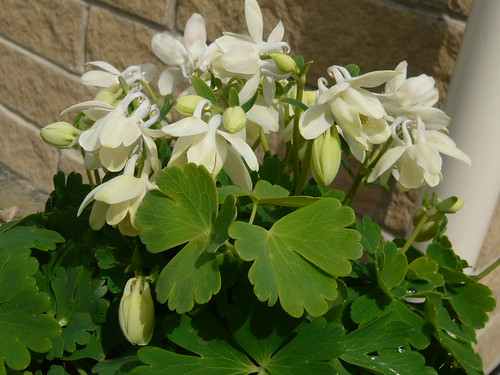Columbines, Aquilegia, Paraquilegia & Semiaquilegia
Genetic purity cannot be guaranteed with a species that has been bred and cultivated for centuries. The above Aquilegia flabellata is an alpine species found in Japan and the Kurile Islands. (Flabellata means fan-shaped)
Columbine Growing Tips
- A porous soil is better than hard clay but Columbines grow in most soils preferring alkalinity.
- Columbines like partially shady spots, and may be happy planted under leafy trees.
- With long tap roots, they establish themselves where they are planted, so they may be difficult to move after a couple years.
- Plants are hardy and do not require extra fertilizer.
- Columbines are relatively pest and disease free but aphid attacks may need treatment
Columbine Features
- Columbines range from 4″ to 4′ high
- Columbines last 4 years and more depending on variety. You can extend life expectancy by cutting down flowered stalks prior to seeding.
- Grow these beauties from seed – a variety pack of columbine seeds will no doubt delight you with the end product. If you are in a hurry you can buy pot grown plants but division of plants is seldom successful.
- Columbines cross-pollinate readily and willingly so it can be fun growing from your self- collected seed.
- 65 species are discussed in Robert Nolds book ‘Columbines’
More photos on Growing Aquilegia
The long spurred Aquilegias are showy perrenial plants that are easy to grow from seed sown March to June. These cottage garden favourites grow up to three feet tall on thin stems without hindering other plants. They are not too fussy about conditions tolerating some shade and dry spells.
Tips on growing – Aquilegia
- Aquilegias can be grown and used as cut flowers.
- There are smaller varieties for rock gardens and patio pots such as A .Tiddlywinks
- For a quick impact buy ready grown plants
- Spurless double flowers like A. Noral Barlow and A William Guiness tend to be longer lived but I think they are less showy.
- A. chrysatha is tolerant of shade try A. Yellow Queen and I like A. vulgaris with pure white flowers and grey green foliage.
- The plants can be short lived but self sow and hybridise with other aquilegias. This can lead to inferior smaller seedlings and it may be best to start again as the plants are so easy to grow.


One thought on “Columbines, Aquilegia, Paraquilegia & Semiaquilegia”
Nice tips! This site is a great resource!
Comments are closed.